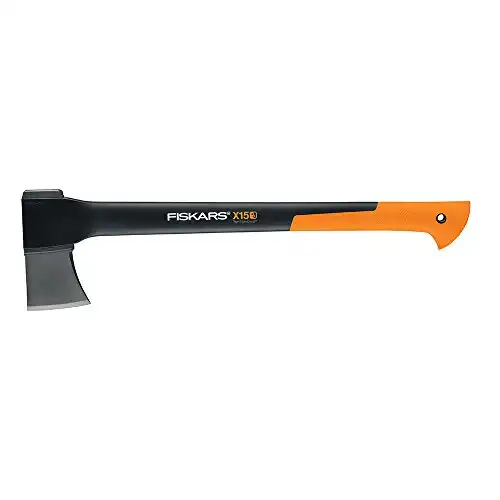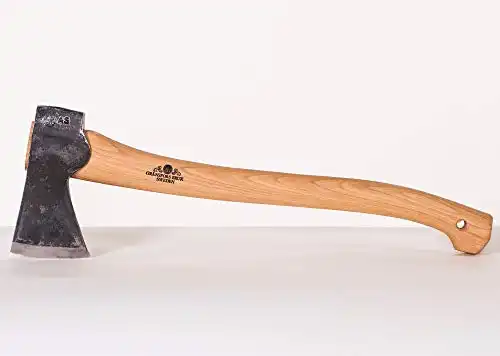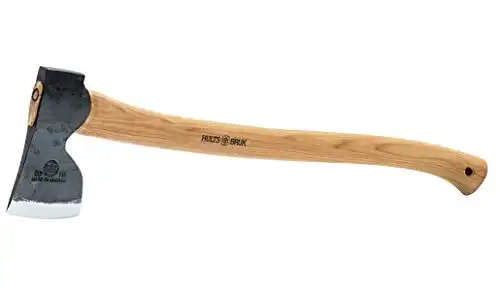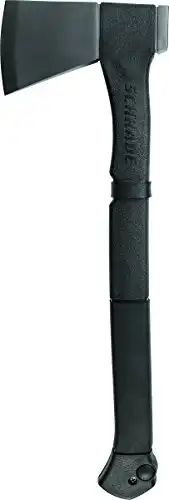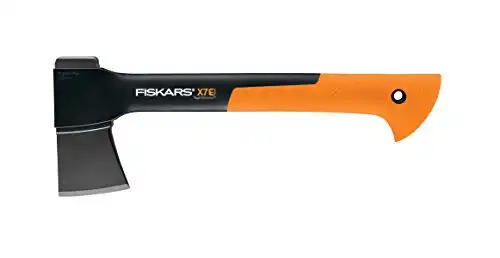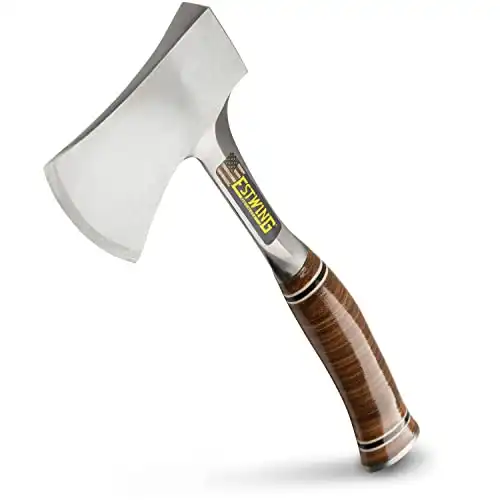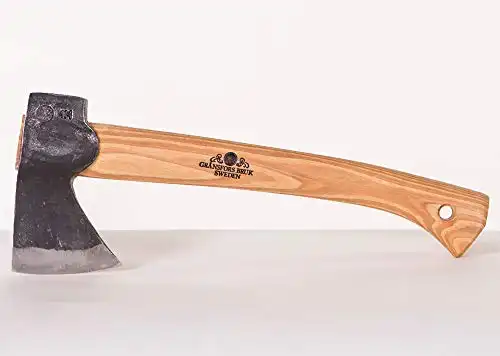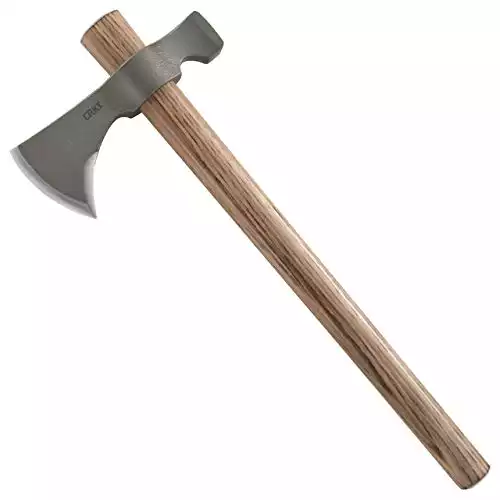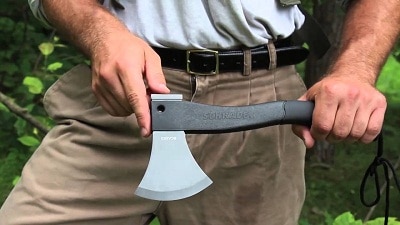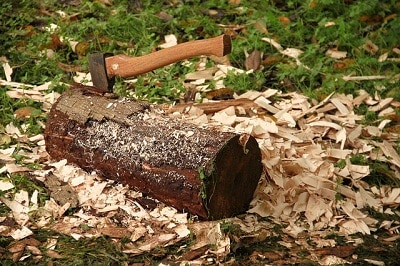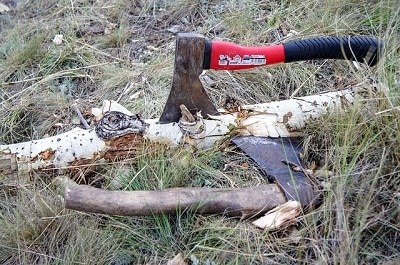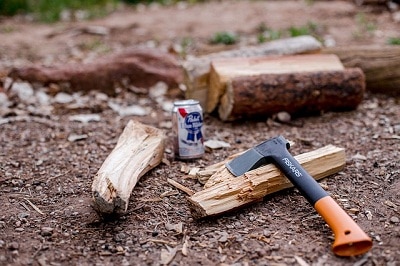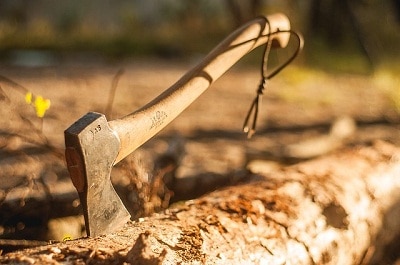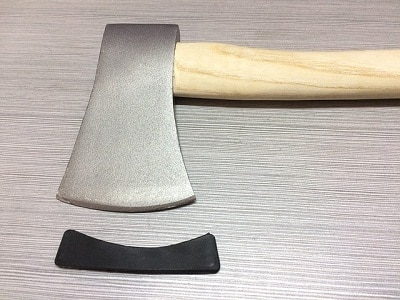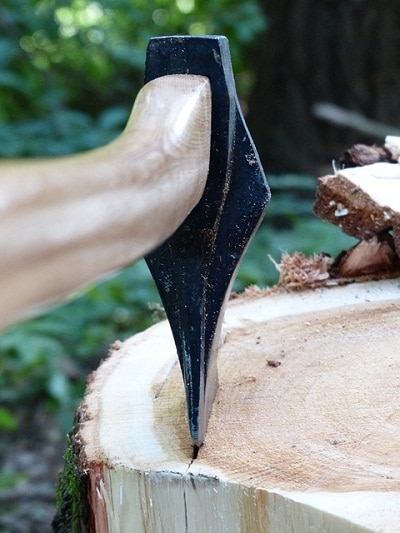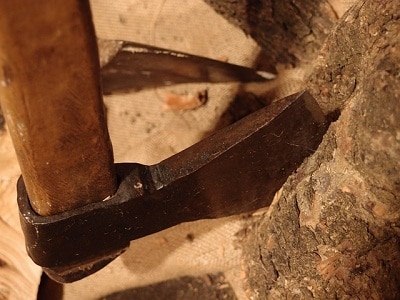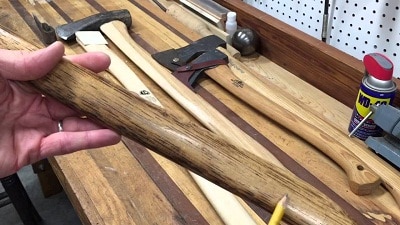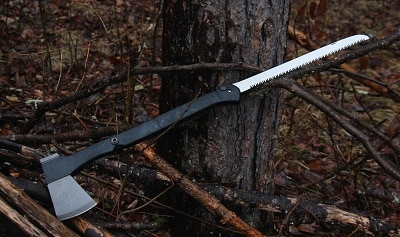Axes are an important tool for survival in wooded areas.
With an axe, you can process a tree into firewood, construct shelter, and even defend yourself.
However, if you look for survival axes on various online stores, your results will be flooded with a multitude of useless axe-shaped objects. They are often part of a “survival kit” or are multi-tools, all black and edgy.
At best, buying one of those is throwing your money away. Chances are you’ll find them useless in the woods.
At worst, they can catastrophically break and injure you!
A good survival axe won’t have a bunch of whizz-bang accessories. It’ll be a good, simple axe, sharp and durable. Just smaller and lighter than a workhorse splitting or felling axe.
I keep an axe in my truck. It’s seen use when civilization wasn’t around to pick me up. Let’s find a good axe for you, too.
DISCLOSURE: As an Amazon Associate I earn from qualifying purchases. Links in this article are affiliate links. If you click on a link we may earn a commission if you make a purchase, at no additional cost to you.
The 8 Best Survival Axes & Hatchets: Outdoor Empire Reviews
- Best Budget: Fiskars X15 Chopping Axe
- Best Compact: Gränsfors Bruk Small Forest Axe
- Most Versatile: Hults Bruk Akka Forester’s Axe
- Best Survival Axe with Saw: Schrade SCAXE9CP
- Best Budget Survival Hatchet: Fiskars X7
- Best Steel Handle Survival Hatchet: Estwing Sportsman’s Axe
- Overall Best Survival Hatchet: Gränsfors Bruk Wildlife
- Best Survival Tomahawk: CRKT Woods Chogan Tomahawk
| Category | Best Compact | Best Overall Hatchet | Best Tomahawk |
|---|---|---|---|
| Model | 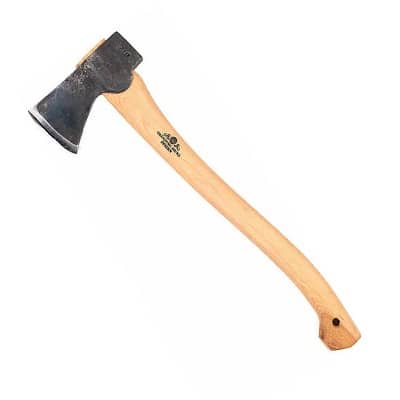 | 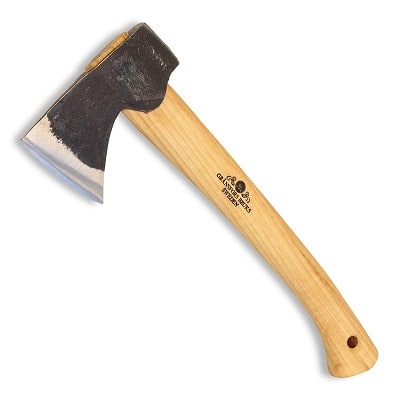 | 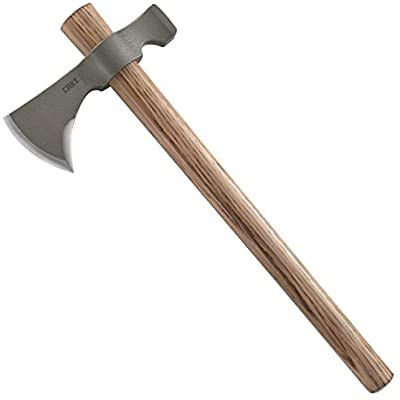 |
| Head Material | Proprietary steel | Proprietary axe steel | 1055 carbon steel |
| Head Weight | 1.5 lbs | 1 lb | 1.5 lbs |
| Overall Weight | 2 lbs | 1.3 lb | 2 lbs |
| Handle Length | 19 in | 13.5 in | 19 in |
| Handle Material | Hickory | Hickory | Hickory |
| Cost | Check Price | Check Price | Check Price |
1. Best Budget Survival Axe
- Inexpensive
- Nearly indestructible handle
- Versatile head geometry
- Mediocre sheath
- On the heavier side
- Head Material: High-carbon steel
- Head Weight: 2.3 lb.
- Overall Weight: 3.4 lb.
- Handle Length: 23.5 in.
- Handle Material: DuraComp
Overview
The Fiskars X15 Chopping Axe is a very modern-looking axe. The forged high-carbon steel head has a uniformly gray low-friction coating that also helps prevent rust. The handle is made from rubberized composite materials.
So, it looks a bit alien in a natural environment. But that’s where it thrives.
The axe head is well designed for many tasks. Fiskars calls it a chopping axe. The edge geometry and head weight mean this axe is good at felling medium to small trees. However, the cheeks are thick enough for you to split logs without much fuss.
The 23.5-inch handle is extremely durable. The DuraComp material (or FiberComp, depending on who you ask) is stronger than steel when it comes to impacts. A bad swing won’t put your axe out of commission.
The handle is good at absorbing shocks and doesn’t become slippery when your hands are sweaty.
The X15 is heavier than similarly sized axes, but not by much. It weighs 3.4 pounds. Weight adds up in survival situations, but this shouldn’t cause too much of a problem.
The sheath, though, is large and annoying. It’s good for mounting your axe to a car or boat but isn’t good for the forest.
Recommendation
The Fiskars X15 Chopping Axe may be a budget option, but it’s by no means a poor survival axe. In fact, it’s one of the best!
2. Best Compact Survival Axe
- Compact and lightweight
- Good for light chopping and finer tasks
- Hand-forged steel
- Expensive
- Not great for splitting
- The shorter handle reduces leverage
- Head Material: Proprietary steel
- Head Weight: 1.5 lb.
- Overall Weight: 2 lb.
- Handle Length: 19 in.
- Handle Material: Hickory
Overview
The Gränsfors Bruk Small Forest Axe is the darling of bushcrafters the world over. Those folks practice survival every day. The Small Forest Axe is one of the most famous bushcrafting axes for a reason.
It’s a small axe. Larger than a hatchet, but not by much. The handle is 19 inches long, and the axe head weighs a scant 1.5 pounds. This axe won’t weigh you down, is unlikely to get caught on the brush, and can do more than a hatchet.
However, while it is pretty versatile, it’s not the axe to end all axes. You won’t get much momentum with the small head and short handle, so it can’t fell larger trees. Also, the cheeks are thin, so the Small Forest Axe is not good at splitting even medium logs.
It is better than larger axes for carving and making feather sticks, though. Plus, if you sharpen it right, you can shave with this axe!
It also comes with a vegetable-tanned leather sheath and Gränsfors Bruk’s Axe Book.
Recommendation
The Gränsfors Bruk Small Forest Axe is a great little axe, but it’s expensive and not as efficient as an axe with a longer handle. Get it if compactness is important, but you still want a two-handed axe.
3. Most Versatile Survival Axe
- Jack-of-all-trades
- Longer handle without adding too much weight
- Takes up more space than other survival axes
- Head Material: Swedish axe steel
- Head Weight: 1.5 lb.
- Overall Weight: 2.2 lb.
- Handle Length: 24 in.
- Handle Material: Hickory
Overview
The Hults Bruk Akka Forester’s Axe is similar to the Small Forest Axe but has several important differences.
Most important is the longer handle. The Akka has a 24-inch handle, which increases your leverage so you can swing faster without more effort. This makes it better for chopping.
It also has a finger notch cut into the base of the axe head, between the beard and the handle. This lets you choke your hand up the handle and grip the axe closer to its center of balance. That way, you get more control over more delicate tasks.
That notch also allows the cheeks to be thicker without adding extra weight. The cheeks aren’t as thick as a traditional splitting axe, but they are triangular enough for this axe to split smaller logs without getting stuck.
The Akka comes with a leather sheath. It also comes with a user’s manual for folks new to axecraft, and it even a storage box if you don’t want to immediately lash it to your bugout bag.
Recommendation
The Hults Bruk Akka Foresters Axe is a versatile traditional axe capable of performing many forestry tasks, if the longer handle is not a problem.
4. Best Survival Axe with Saw
- Corrosion resistant
- Includes 12.5-inch saw
- Short handle
- The stainless steel doesn't hold as good an edge as high-carbon steel
- Head Material: Titanium-coated 3Cr13 stainless steel
- Head Weight: Not stated
- Overall Weight: 2.2 lb.
- Handle Length: 18 in.
- Handle Material: Glass-filled polymer and rubber
Overview
I’m generally not a fan of combination tools. A separate axe and separate saw will work better than a combination axe and saw.
However, these combo tools save both space and weight. In a survival situation, both will be at a premium. A good axe/saw combo can be a good choice in an emergency.
However, there don’t seem to be too many “good” axe-and-saw combos out there. Many are under-engineered and have weak points or have a poor-quality blade, saw, or both.
The Schrade SCAXE9CP, however, is one of the rare good combo axes.
It’s made of lightweight materials, from the glass-filled polymer handle to the titanium-covered stainless-steel head. It only weighs 2.2 pounds, including the saw blade.
The axe won’t hold the best edge because of the stainless steel, but it’s still better than some axes I’ve used. The saw has aggressive teeth that are effective at cutting through branches.
A locking mechanism keeps the saw in the handle while you’re chopping. When you unfold it, the saw locks in two positions, one for higher use and the other for lower use.
The biggest weakness is the short handle: 18 inches doesn’t give you much leverage compared to other survival axes.
Recommendation
The Schrade SCAXE9CP is a good way to have both axe and saw in one tool.
5. Best Budget Survival Hatchet
- Lightweight
- Surprisingly effective at splitting for a hatchet
- Tough handle
- Some chipping concerns (may just be the coating, though)
- Head Material: High-carbon steel
- Head Weight: Not stated
- Overall Weight: 1.38 lb.
- Handle Length: 14 in.
- Handle Material: FiberComp
Overview
The Fiskars X7 Hatchet is the smaller sibling of the X15 axe. It’s effectively a one-handed version of the larger chopping tool.
As such, it has many similarities. You get the same FiberComp handle that’s lightweight, provides overstrike protection, and is comfortable in the hand. This one is almost a full 10 inches shorter though, at 14 inches in length.
The head is very similar, with a low-friction coating and high-carbon steel. It’s smaller, naturally. The whole hatchet weighs a scant 1.38 pounds!
The blade also flares out from the edge to just before the eye, so it’s a surprisingly effective splitting hatchet. It’s also pretty good at chopping and can also be used as a hammer, though you don’t want to hammer steel.
Some users have reported their edges chipping. This might be the non-stick coating. It’ll chip off, then you can sharpen the bare steel underneath and have an effective, inexpensive, and durable hatchet.
Recommendation
The Fiskars X7 Hatchet is lightweight and has a good handle. The chipping may concern some people, but that might be the coating instead of the metal itself, as the larger X15 doesn’t have the same problem.
6. Best Steel Handle Survival Hatchet
- Better for chopping than some hatchets
- Very durable handle
- Handle leather needs work before it's comfortable
- The thin cheeks aren't good for splitting
- Head Material: 1055 carbon steel
- Head Weight: Not stated
- Overall Weight: 1.7 lb.
- Handle Length: 14 in.
- Handle Material: Stacked leather over steel
Overview
The Estwing Sportsman’s Axe is a made-in-USA hatchet with a steel handle and leather grip.
The head flares out, so it has a surprisingly long cutting surface. It also comes with a mirror finish, which fulfills three purposes: it resists corrosion, it reduces friction, and it looks nice.
The steel extends into the handle. All the way.
Normally, this would mean uncomfortable hand shock. But the Estwing Sportsman’s Axe has stacked leather spacers over the steel, which helps to minimize shock and make the hatchet more comfortable to use.
However, they come lacquered, which makes them shiny and slick. Also, if any water gets under the coating, it’ll cause the leather to rot from the inside out!
Before using this hatchet, you should take care of that.
It’s recommended to sand the lacquer off with a 100-grit piece of sandpaper. Then, apply some sort of leather protectant. I’m a fan of Huberd’s Shoe Grease.
Recommendation
The Estwing Sportsman’s Axe is a classic hatchet that requires a little bit of effort to make the leather handle comfortable, but it is a good choice for a hard-use hatchet.
7. Best Overall Survival Hatchet
- Environmentally responsible
- Handmade with skill
- Very versatile
- Expensive
- Sometimes slightly off center
- Head Material: Proprietary axe steel
- Head Weight: 1 lb.
- Overall Weight: 1.3 lb.
- Handle Length: 13.5 in.
- Handle Material: Hickory
Overview
The Gränsfors Bruk Wildlife Hatchet is a Swedish wood-handled hatchet.
The head is made from Gränsfors Bruk’s proprietary axe steel. It weighs 1 pound, which is pretty light, but that’s a boon for people saving ounces.
The 13.5-inch American hickory handle is comfortable to use and gives you enough leverage to chop down small trees.
The Wildlife Hatchet’s geometry is different than the Small Forest Axe’s in that the top curves down a little bit. It’s still a very versatile tool and can be used for (light) splitting, carving, limbing, and more.
The handle’s hickory comes from responsibly-managed forests. The head’s steel is made from recycled scrap metal by Ovako. The only way to buy an axe or hatchet with less of an environmental impact is to restore a vintage hatchet!
It also comes with a leather sheath and the Axe Book.
Now, some users have reported that their hatchet came off center, so the edge didn’t match up with the center of the handle. In most cases, this doesn’t affect the use very much, but it can annoy perfectionists.
Recommendation
The Gränsfors Bruk Wildlife Hatchet is a handsome, comfortable, and versatile hatchet that can see you through the wilderness. However, it’s much more expensive than other hatchets, which are 98 percent as effective.
8. Best Survival Tomahawk
- Both weapon and tool
- Handle is easily replaced
- Not as effective for tough tasks
- Sheath sold separately
- Head Material: 1055 carbon steel
- Head Weight: 1.5 lbs
- Overall Weight: 2 lb.
- Handle Length: 19 in.
- Handle Material: Hickory
Overview
Most people think of tomahawks as weapons, not survival tools.
However, they can be good at the light tasks you need to perform in order to survive in the wilderness.
The CRKT Woods Chogan Tomahawk is probably the best ‘hawk for survival purposes.
Like all ‘hawks, the head is not permanently attached to the handle. I’ve used a branch to replace my tomahawk’s handle in a pinch, which you can’t do with any other type of axe.
Also, the Chogan’s poll is a hardened hammer, increasing the ‘hawk’s utility. You can also remove the handle to turn it into a scraper, just in case you want to turn a deer’s hide into clothes.
The head does have thin cheeks. So, while it’s okay at chopping, it’s less effective at splitting wood. It’ll get stuck in larger logs.
There are two sheaths available for the Chogan. One is a blade mask, while the other incorporates a blade mask and straps for both the hammer poll and the handle.
Unfortunately, neither come with the ‘hawk, and they have to be purchased separately.
Recommendation
The CRKT Woods Chogan Tomahawk is a surprisingly effective survival tool. It’s a hatchet and hammer. Then, if the handle breaks, you can replace it in a matter of minutes!
Why Do You Need a Good Axe or Hatchet for Survival Situations?
If you hope to survive in the wild, you need a blade.
A sharp rock, however, will only get you so far.
Knives are extremely useful. Truly, everyone should have several survival knives at the ready. But a knife is a small blade that’s not good for activities which require sharp striking force.
I’m talking about chopping and splitting.
Good luck felling a tree with a Morakniv Companion!
A good axe or hatchet will allow you to process wood you can’t touch with a knife. You’ll be able to chop down a tree, remove the limbs, buck the trunk into logs, shave off bark for kindling, and split the logs into firewood.
You can also use an axe to break through ice to get to water, chop through connective tissue to clean a deer, lay down tent stakes by using the axe as a hammer, and create poles for shelter by using it as a carving tool.
Axes and hatches are also more effective weapons to fend off a predator than a dinky knife.
Everyone who spends some time in the forest, whether on purpose or because SHTF, should have an axe. Or two.
A multipurpose axe is a good jack-of-all-trades tool. A dedicated larger axe and a hatchet both cover each other’s weaknesses.
However, even just a hatchet can allow you to do so much that it could mean the difference between life and death.
Note, however, that axes are only good if there’s wood around. A good machete is a better choice in certain parts of the world.
How to Choose
So, you want an axe for survival situations, but don’t know which one to get.
Improper tools are unsafe to use. Axes are no different. You don’t want to injure yourself when you’re in the wild, so be sure to pick the right axe for your environment. And learn how to use an axe safely!
Axe vs. Hatchet
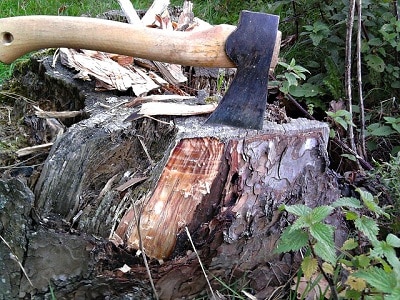
One of the most important decisions to make is whether you should get an axe or a hatchet.
Hatchets are basically one-handed axes. They have shorter handles than axes, typically under 16 inches. You can put a second hand on the handle, but you won’t get as much out of it as a longer axe handle.
Axes are blades and can be used for many tasks that require blades. However, there are several tasks which axes excel at, especially chopping.
You won’t be able to chop into a tree trunk or chop off a tree limb as effectively with a hatchet.
However, survival axes are not supposed to see you through the construction of a log cabin. You use them to process wood into firewood so you can survive the night.
In other words, survival axes don’t have to be the biggest, strongest axes. If you know how to use them, you can save lots of weight with a hatchet.
Plus, hatchets are much easier to store and carry with you. Then, when you’re in the woods, a hatchet’s lighter weight can save some much-needed calories.
Handle Length
Tied closely into the axe-versus-hatchet conundrum is handle length. Whether you have a two-handed axe or a one-handed hatchet, some will have longer handles than others.
A longer handle allows you to move the head at a faster rate of speed. This causes deeper impacts with the same amount of manual effort, getting you through the tree faster.
However, longer handles take up more space and weigh more. If you’re in a survival situation, you may want as little weight as possible. It’s even possible for a too-long axe to give away your position if you need to be stealthy, especially one with an orange handle.
I’ve found that 19-inch handles can be attached to a hiking or bugout backpack without getting in the way. Longer handles may work better, but they’re more likely to be obstructive.
A 14-inch or shorter handle, such as on a hatchet, may fit inside your backpack. This keeps it out of the elements.
Blade Shape
Axes pretty much always have a curved edge, typically around 3.5 inches long. Experience through the centuries has found this to be an optimal shape for chopping, splitting, and other axecraft activities.
However, the shape from bit to eye can have a large impact on how well the axe works for certain tasks.
If you didn’t know, the bit is the front part of the axe, and the eye is where the axe curves around the handle. The side of the axe in between is called the cheek, and this is what we’re concerned about.
Thinner cheeks are better for penetration. This is why most felling axes will have thin cheeks. Tomahawks, too. Though since tomahawks are weapons, it’s not wood they’re supposed to penetrate.
However, if you take a thin-cheeked axe and try to split a larger log, it’ll penetrate without forcing the two halves apart. I’ve stuck my tomahawk into a log this way.
Several times.
Cheeks which are thicker than the eye, on the other hand, are great for breaking apart logs into firewood. This lateral force is more effective than the same amount of force straight down.
Cheeks which angle straight from the edge to the eye present a good compromise. That axe won’t be quite as effective at chopping, but it will be able to split logs better than one with thin cheeks.
However, there is a trick for splitting logs with a tomahawk or other thin-cheeked axe:
Set the log on its side.
If the log is not too wide but is more than a little tall, then a thin-cheeked axe will have more luck splitting it from the side rather than top down.
Head and Overall Weight
Because the amount of weight you carry is so important during emergencies, lighter survival axes are almost always better than heavier survival axes.
However, this comes at a drawback. Heavier axe heads are more effective at biting deep into wood than lighter axe heads on handles of the same length.
What does your survival plan look like?
If you’re planning on becoming a wild woodsman, then you may want to store away a heavier survival axe so you can handle more intensive activities.
On the other hand, if your survival plan involves lots of travel (especially to a safe destination) then you may want to err on the side of saving weight. You’ll travel lighter, faster, and use fewer calories.
Handle Material
I’m partial to wooden axe handles. Even in a survival situation.
Wood may not seem like the best idea if you need to heavily rely on a bladed tool, but it has an advantage that composite, polymer, or metal handles lack:
You can replace the handle.
Also called “hanging an axe,” making a new haft in the woods and attaching it to the old axe head is a great option to have. Handle replacement kits come with metal wedges to properly hang an axe. Or, you can carve a handle and wedge from found wood and do it all yourself.
You can’t do that with a steel or polymer handle! The best you can do with those is hack together a temporary repair. For example, you might be able to stick a branch into a hollow composite handle and lash it to the head.
That solution won’t be as durable as a properly hung axe, though.
So, while composite and steel handles may be less likely to break in the woods, any damage will be more catastrophic.
Extra Tools
Multi-tool axes are a divisive topic.
Some people appreciate how combining two or more tools into one saves space and weight. Other people think it’s foolish because the combo tool won’t be as good as either tool separately, and if one function breaks, the whole tool might become unusable.
Personally, I’m not a fan of axes with built-in saws or other tools. They might have a place in your survival kit, though!
Also, all axes have what’s called a “poll,” which is the part of the axe head on the side of the handle opposite the edge.
Most axe polls aren’t designed for hammering. The eye is made from softer steel than the rest of the axe head so it can absorb shocks from chopping without shattering. Hammering, however, puts more stress on the eye, which can cause it to deform.
Also, many polls aren’t hardened, which can cause damage to the axe if you strike a metal or stone object.
However, some axes do have hardened hammer polls. Oddly enough, I’ve seen this most often on tomahawks.
These axes shouldn’t be used long-term for hammering but are more than capable to see you through any hammering you may need to do to survive!


